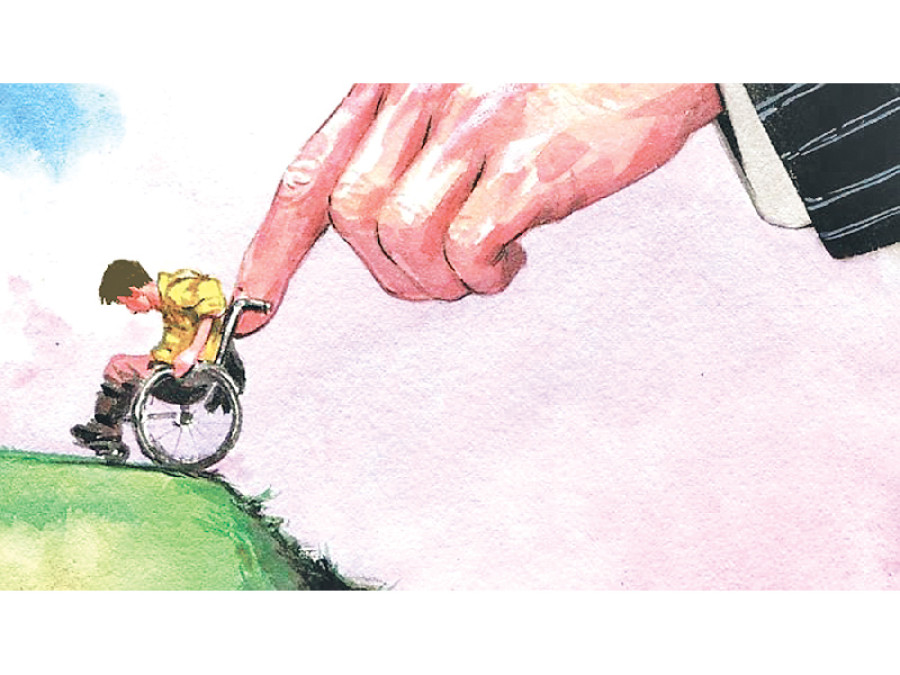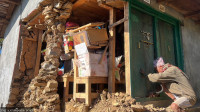Opinion
Leave no one behind
Planners should focus on people with disabilities to ensure inclusive development
Sudarshan Neupane
As the UN Millennium Development Goals (MDGs) conclude this year, a recent report has highlighted their success in lessening poverty and improving the lives of the world’s poor, including persons with disabilities. The UN Secretary-General proudly announced that the MDGs had resulted in the most successful anti-poverty movement in history by lifting over a billion people out of extreme poverty, enabling more girls to attend school and protecting our planet. Regrettably, the MDGs have been unsuccessful on the disability-inclusion front, and this has amplified inequalities. The Sustainable Development Goals (SDGs) which are being confirmed in September will build on the accomplishments and limitations of the MDGs. Disability issues have been recognised in the upcoming SDGs and they seek to make targeted efforts to ensure that people with disabilities are included.
Recommendations for the SDGs by the High-Level Panel emphasise powerful and aspiring themes, including leaving no one behind. However, in a developing country like Nepal, nearly 95 percent of the people with disabilities live below the poverty line, and more than two-thirds do not receive basic education, healthcare services and vocational training for employment. Therefore, would it actually be possible to leave no one behind and achieve inclusive development for everybody?
Advancements and gaps
Nepal is on track to achieve most of the MDGs, together with some major reforms in the social policies, despite recent political and economic upheavals. The overall targets set for poverty reduction, maternal and child mortality and primary level enrolment have been fully or partially achieved. Still, there is a huge gap in the achievement of these indicators for the disabled. Presumably, this striking gap exists as the MDGs failed to set targets for disability in any of the eight goals and the Millennium Declaration.
Several thousand children with disabilities still do not attend schools, and many disabled persons cannot obtain primary healthcare services as building structures are not accessible to them. Consequently, less than four percent of the disabled population has access to meaningful livelihood opportunities. Their isolation is a result of impairments as well as a judgmental social attitude.
Beyond MDGs
Considering lack of specific policies and existing gaps in ensuring that persons with disabilities are included in the development framework in the MDGs, the UN Secretary-General has launched an effort entitled ‘The Way Forward: A Disability-Inclusive Agenda towards 2015 and Beyond.’ It stresses on accessibility as the central theme. Past experiences have shown that mainstream development projects, regardless of their focus on social inclusion, have failed to benefit these groups. There is still a lack of awareness among development actors with regard to their needs, and they have failed to address accessibility in the design, implementation and monitoring of the project. To meet the targets of the post-2015 SDGs, Nepal needs to harness the potential of all the citizens including persons with disabilities.
Persons with disabilities are best served through a twin-track approach—ensuring the mainstreaming of services and creating specialised disability-focused interventions in the programmes and services. Given the lack of monitoring and the failure to set targets in public services and incentives, there is a need to agree on specific targets in the incentives and packages to lift these economically and socially excluded groups. Similar to gender, disability concerns need to be acknowledged as a cross-cutting issue.
In Nepal, a very small amount of the national budget is allocated for the welfare of persons with disabilities—health, education and job-related training. This has a direct impact on their quality of life and economic inclusion. According to a New Era Research, nearly 70 percent of the persons with disabilities depend on family members for their healthcare and other special needs.
Step forward
So if Nepal is to ensure that no one is left behind in the development process, the government and the private sector need to work together to improve financing for persons with disabilities. The lessons acquired from the MDGs should be reflected in the planning process. Also, it would be unrealistic to expect the government to solve all the problems faced by these vulnerable groups. Therefore, more domestic resources and external development assistance are essential. An increased budget allocation and improved coordination with public-private partnership would go a long way in addressing the underlying issues of the disabled community. Similarly, experiences from different countries have shown that appropriate opportunities for persons with disabilities will not only help them lead decent lives but also promote inclusive development.
In order to ensure the meaningful participation of persons with disabilities, health, education and capacity enhancement services should be made accessible and available to them. Likewise, to ensure inclusive growth post-2015, a substantial leap forward in economic opportunities, innovative disabled-friendly technologies for employment and ethical business investment for persons with disabilities, even in rural communities, is crucial. Strong advocacy and collaboration among agencies is essential to provide gainful livelihood opportunities too.
To conclude, the encouraging goals set by the SDGs can only be achieved if all the political parties and civil society work together. It is more important for the government to commit more funding to make the SDGs a reality in Nepal.
Neupane is Livelihood Advisor at Handicap International. Views expressed in this article are personal




 15.12°C Kathmandu
15.12°C Kathmandu










